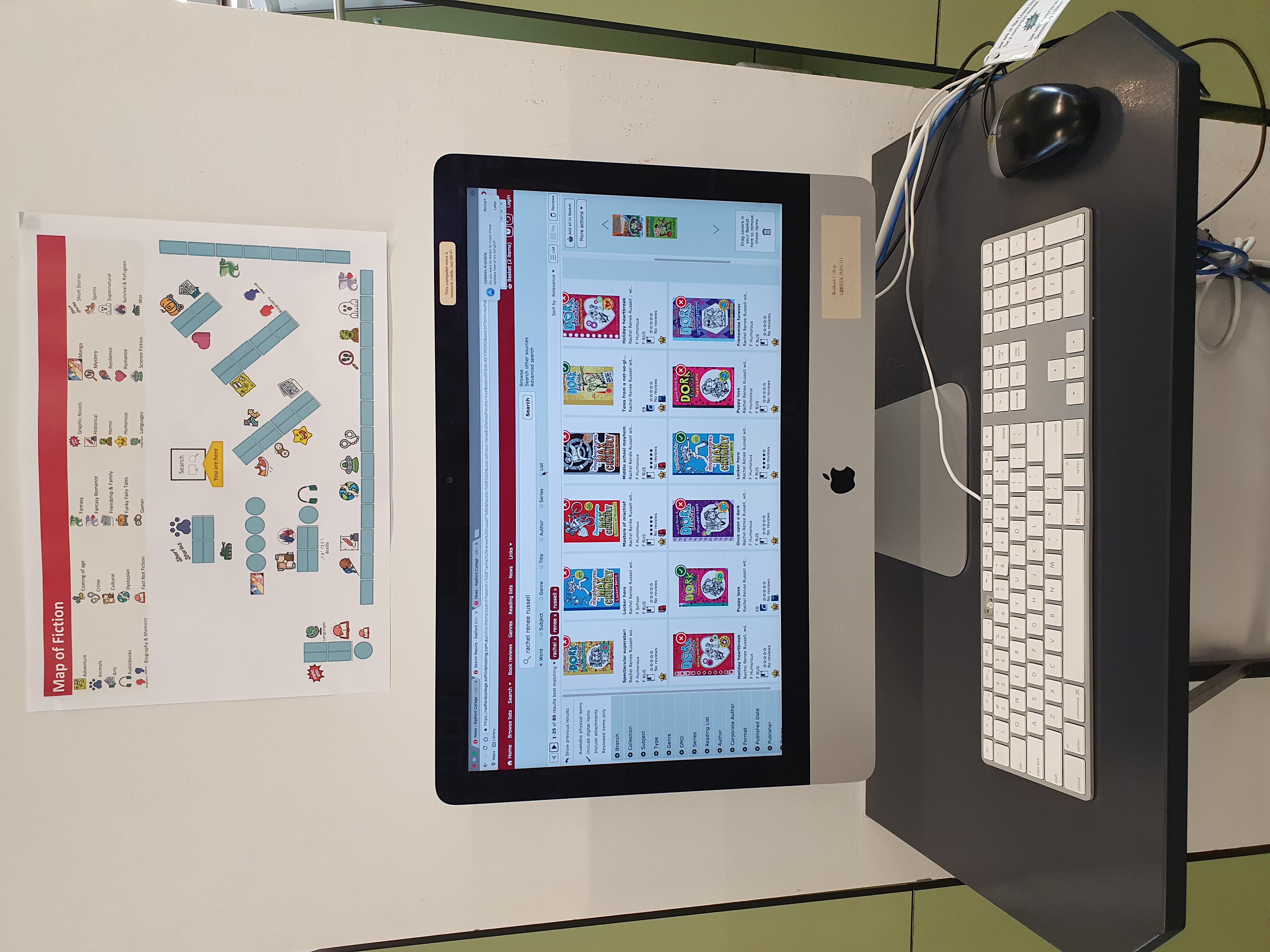Issue 117
Term 2 2021
Genrefication 3.5 years later: Reflections
In 2017 Susan Davenport wrote an article for Connections discussing the process Radford College took to genrefy their senior library’s fiction collection. Three years later, Susan reflects on the library’s genrefication journey.

Radford College Secondary Library (SL) for years 5–12 students began our genrefication journey in 2017. This article reflects upon those first steps and what changes have been implemented since.
What have we learnt?
Genrefication works!
Yes, it really does. Our years 5–12 students find the SL collection easy to navigate. They know where their favourite genres are, and they regularly peruse the shelves. They move beyond their known authors and have a good rummage amongst the shelves for similar titles by authors new to them. At the shelves, students will often select within an arm’s reach if their desired title is not there, demonstrating a confidence that the selection will be relevant.
You’re never finished
Genrefication is a fluid entity – it allows the library to be responsive to trends, curriculum, and react to borrowing data. This flexibility is key and requires an agile team who are prepared to undo previous work for the benefit of their users. We have added, decommissioned and changed whole genres!
Review your loans statistics
The loans statistics are a great data-driven insight into your collection. You can identify trends unique to your library. Data can:
• correct perceptions of genre popularity you may be inadvertently basing on 5+ years ago
• identify an emerging or overlooked genre
• indicate that a genre needs to be decommissioned and the titles redistributed.
Perfection is unattainable
You’re going to get some things wrong. Unclear genre images, names or catalogue use may need to change, and that’s OK! We regularly consult sources such as SCIS genres, subject headings and Goodreads, but some titles could fit several genres, for example, a time-travelling, magic-wielding, adventure-comedy-romance. Pick the best one and see how it goes. Moving a languishing title into a different genre could change its borrowing rates.
Flexibility in shelving and layout
When you’re not limited to an A to Z run that has to have a logical flow, you have a lot more flexibility in how your shelving is arranged. We have experimented with many configurations, which can change not only loan rates, but also library design and use.
Some things become easier
• A book mis-shelved in the wrong genre is easily spotted and resolved.
• Stocktake in genres breaks a massive project into smaller manageable chunks.
This flexibility is key and requires an agile team who are prepared to undo previous work for the benefit of their users. We have added, decommissioned, and changed whole genres!
Project one: biographies
In discussion with our Head of English, we sought to better support the Year 9 Biography unit.
Students find it challenging to choose a biography as most are about people they don’t know and the covers usually assume some knowledge. The project objectives were to:
• identify subgenres, acknowledging that some will be very small, that may appeal to students
• differentiate between a biography and memoir.
The result is a SL Biography/Memoir collection divided into subgenres. The genre label has Biography or Memoir written under the genre image. This has had a positive result for our students who can narrow their selection to 1.5 shelves instead of the entire A to Z Biography section.
The Biography/Memoir subgenres are: Adventure, Animals, Arts, Crime, Cultural, Education, Leaders, Medical, Resilience, Sports, STEM, Survival & Refugees, Travel, and War.

Great idea! Have a map at the OPAC with the layout and genre images.
Project two: Junior Library collection
The Junior Library (JL) for years K–4 took the plunge and genrefied their novels. In reviewing the existing set of SL genres, the smaller collection needed fewer genres that were tailored to the interests of Junior students.
Having gone through the process once, the whole library team collaborated to find the genres and implementation methods that would best suit the collection and users. There was much discussion about which collections should be genrefied using which genres, and which collections suited a different path.
The key aspects of the revamped Junior Library collection are:
• an A–Z Picture Books collection
• First Chapters collection which is predominately in boxes by series or theme
• genrefied novels.
With teacher-librarian-led introduction and guidance, our students find the arrangement of the collection easy to use, and respond well to the genres. Much like the years 5–12 students before them, they have found the same benefits of choosing within an identified genre: reducing the feeling of being overwhelmed by choice, and making exploring new titles easier. It encourages library lesson activities that challenge them to borrow from different genres and allows for data-driven management.
Managing genrefication across two libraries
Where the genres are the same in both libraries, the same image and language is used. This has had a positive outcome of recognition when Junior students transition to the Secondary Library!
If a title is in both libraries, it is absolutely fine for it to be in different genres. We consider it more important to be relevant to our users, for example, the Max Crumbly series is in School (JL) and Humorous (SL).
Project three: label icons
In 2020 we had a long look at the labels that we were using to represent our genres. The majority of these were commercially purchased with a few that we had made ourselves. Some were a good fit, others were obtuse, and there was little cohesion. On looking at the set as a whole, it was clear that there was a definite bias towards Caucasian males and Eurocentric images.
The team commenced a collaborative process of choosing neutral images that avoided gender and race, and were a clear representation of the genre. We asked students which images spoke to them best. Where the genre was used in both libraries, it was important that the image was understandable by all ages. Some were an easy choice, while others were excruciatingly challenging.
Our new images were sourced from creative commons icon websites and catalogued individually to include the necessary attribution requirements.
Genrefication top tips
• Invest each year in educating your new students and all relevant staff about how the system works.
• Be prepared to revisit a decision and redo previous work.
• Note what your users are asking for – is there an emerging trend? Is an aspect confusing?
• Have clear signage that is consistent in style for a professional retail look.
• Have a map at the OPAC with the layout and genre images.
• Explore your catalogue’s features and talk with the software provider.
• Include the genre labels on the catalogue as people are very responsive to visual images.
• Create your own labels that speak to your users.
• Use labels that are easily removed so that a change 2 years later is easier to complete (really wished we’d thought of this earlier).
• Create bookmarks with the genre logo to slot into the books during cataloguing. The genre allocation and label application may be some time apart and this has proven very efficient.
Overall, we continue to be really pleased with how the genrefication project was received, implemented, and adapted. It has greatly enhanced our collection and our users are the primary beneficiaries. I would highly recommend that you consider how it could work in your library!
Secondary Library genres: Adventure, Animals, Arts, Coming of Age, Crime, Cultural, Dystopian, Fact not Fiction, Fantasy, Fantasy Romance, Friendship & Family, Funky Fairy Tales, Gamer, Graphic Novels, Historical, Horror, Humorous, Languages, Manga, Mystery & Spies, Resilience, Romance, Science Fiction, Short Stories, Sport, Supernatural, Survival & Refugees, War.
Junior Library genres: Adventure, Animals, Classics, Fantasy, Friendship & Family, Graphic Novels, Historical, Humorous, Languages, Manga, Mystery & Spies, School, Sport.
Image credits
Images supplied by Susan Davenport
